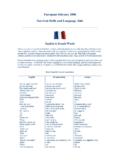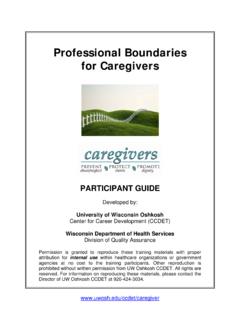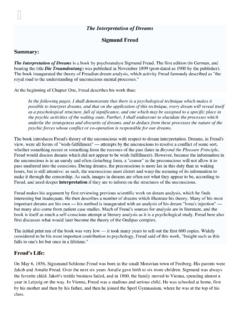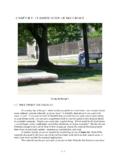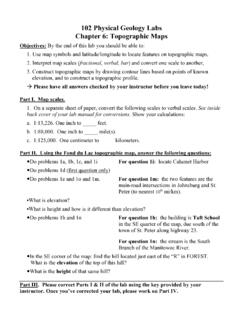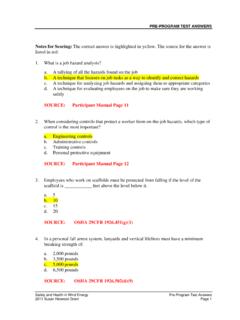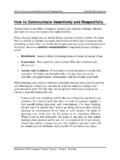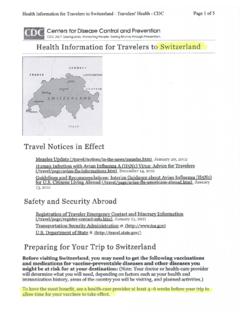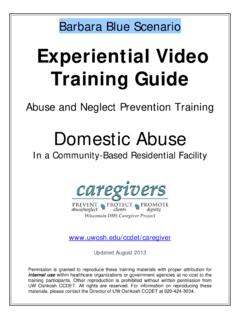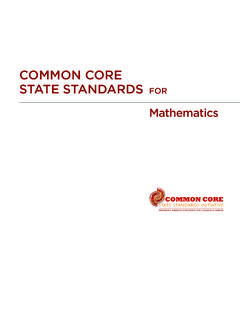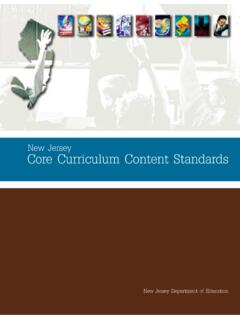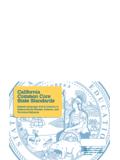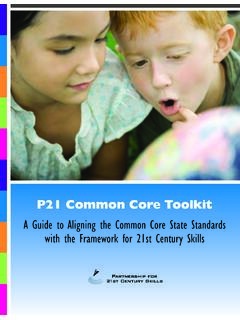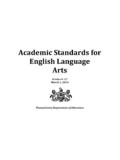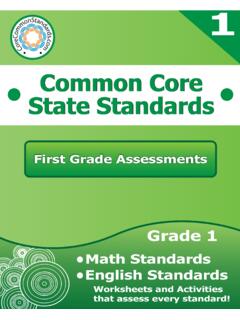Transcription of Common Core Standards Mission Statement
1 1 Common core Standards Mission Statement The Common core State Standards provide a consistent, clear understanding of what students are expected to learn, so teachers and parents know what they need to do to help them. The Standards are designed to be robust and relevant to the real world, reflecting the knowledge and skills that our young people need for success in college and careers. With American students fully prepared for the future, our communities will be best positioned to compete successfully in the global economy. How to read the grade level Standards Standards define what students should understand and be able to do. Clusters summarize groups of related Standards . Note that Standards from different clusters may sometimes be closely related, because mathematics is a connected subject. Domains are larger groups of related Standards . Standards from different domains may sometimes be closely related.
2 These Standards do not dictate curriculum or teaching methods. For example, just because topic A appears before topic B in the Standards for a given grade, it does not necessarily mean that topic A must be taught before topic B. A teacher might prefer to teach topic B before topic A, or might choose to highlight connections by teaching topic A and topic B at the same time. Or, a teacher might prefer to teach a topic of his or her own choosing that leads, as a byproduct, to students reaching the Standards for topics A and B. What students can learn at any particular grade level depends upon what they have learned before. Ideally then, each standard in this document might have been phrased in the form, 2 Students who already know A should next come to learn B. But at present this approach is unrealistic not least because existing education research cannot specify all such learning pathways.
3 Of necessity therefore, grade placements for specific topics have been made on the basis of state and international comparisons and the collective experience and collective professional judgment of educators, researchers and mathematicians. One promise of Common state Standards is that over time they will allow research on learning progressions to inform and improve the design of Standards to a much greater extent than is possible today. Learning opportunities will continue to vary across schools and school systems, and educators should make every effort to meet the needs of individual students based on their current understanding. These Standards are not intended to be new names for old ways of doing business. They are a call to take the next step. It is time for states to work together to build on lessons learned from two decades of Standards based reforms.
4 It is time to recognize that these Standards are not just promises to our children, but promises we intend to keep. Myths vs. Facts Myths About Content and Quality: General Myth: Adopting Common Standards will bring all states Standards down to the lowest Common denominator, which means states with high Standards , such as Massachusetts, will be taking a step backwards if they adopt the Standards . Fact: The Standards are designed to build upon the most advanced current thinking about preparing all students for success in college and their careers. This will result in moving even the best state Standards to the next level. In fact, since this work began, there has been an explicit agreement that no state would lower its Standards . The Standards were informed by the best in the country, the highest international Standards , and evidence and expertise about educational outcomes.
5 We need college and career ready Standards because even in high performing states students are graduating and passing all the required tests and still require remediation in their postsecondary work. Myth: The Standards are not internationally benchmarked. Fact: International benchmarking played a significant role in both sets of Standards . In fact, the college and career ready Standards include an appendix listing the evidence that was consulted in drafting the Standards and the international data consulted in the benchmarking process is included in this appendix. More evidence from international sources will be presented together with the final draft. Myth: The Standards only include skills and do not address the importance of content knowledge. Fact: The Standards recognize that both content and skills are important. 3In English language arts, the Standards require certain critical content for all students, including: classic myths and stories from around the world, America s Founding Documents, foundational American literature, and Shakespeare.
6 Appropriately, the remaining crucial decisions about what content should be taught are left to state and local determination. In addition to content coverage, the Standards require that students systematically acquire knowledge in literature and other disciplines through reading, writing, speaking, and listening. In Mathematics, the Standards lay a solid foundation in whole numbers, addition, subtraction, multiplication, division, fractions, and decimals. Taken together, these elements support a student s ability to learn and apply more demanding math concepts and procedures. The middle school and high school Standards call on students to practice applying mathematical ways of thinking to real world issues and challenges; they prepare students to think and reason mathematically. The Standards set a rigorous definition of college and career readiness, not by piling topic upon topic, but by demanding that students develop a depth of understanding and ability to apply mathematics to novel situations, as college students and employees regularly do.
7 Myth: The Standards suggest teaching Grapes of Wrath to second graders. Fact: The ELA Standards suggest Grapes of Wrath as a text that would be appropriate for 9th or 10th grade readers. Evidence shows that the complexity of texts students are reading today does not match what is demanded in college and the workplace, creating a gap between what high school students can do and what they need to be able to do. The Common core State Standards create a staircase of increasing text complexity, so that students are expected to both develop their skills and apply them to more and more complex texts. Myth: The Standards are just vague descriptions of skills; they don t include a reading list or any other similar reference to content. Fact: The Standards do include sample texts that demonstrate the level of text complexity appropriate for the grade level and compatible with the learning demands set out in the Standards .
8 The exemplars of high quality texts at each grade level provide a rich set of possibilities and have been very well received. This provides teachers with the flexibility to make their own decisions about what texts to use while providing an excellent reference point when selecting their texts. Myth: English teachers will be asked to teach science and social studies reading materials. Fact: With the Common core ELA Standards , English teachers will still teach their students literature as well as literary non fiction. However, because college and career readiness overwhelmingly focuses on complex texts outside of literature, these Standards also ensure students are being prepared to read, write, and research across the curriculum, including in history and science. These goals can be achieved by ensuring that teachers in other disciplines are also focusing on reading and writing to build knowledge within their subject areas.
9 Myth: The Standards don t have enough emphasis on fiction/literature. 4 Fact: The Standards require certain critical content for all students, including: classic myths and stories from around the world, America s Founding Documents, foundational American literature, and Shakespeare. Appropriately, the remaining crucial decisions about what content should be taught are left to state and local determination. In addition to content coverage, the Standards require that students systematically acquire knowledge in literature and other disciplines through reading, writing, speaking, and listening. Myths About Content and Quality: Math Myth: The Standards do not prepare or require students to learn Algebra in the 8th grade, as many states current Standards do. Fact: The Standards do accommodate and prepare students for Algebra 1 in 8th grade, by including the prerequisites for this course in grades K 7.
10 Students who master the K 7 material will be able to take Algebra 1 in 8th grade. At the same time, grade 8 Standards are also included; these include rigorous algebra and will transition students effectively into a full Algebra 1 course. Myth: Key math topics are missing or appear in the wrong grade. Fact: The mathematical progressions presented in the Common core are coherent and based on evidence. Part of the problem with having 50 different sets of state Standards is that today, different states cover different topics at different grade levels. Coming to consensus guarantees that from the viewpoint of any given state, topics will move up or down in the grade level sequence. This is unavoidable. What is important to keep in mind is that the progression in the Common core State Standards is mathematically coherent and leads to college and career readiness at an internationally competitive level.
